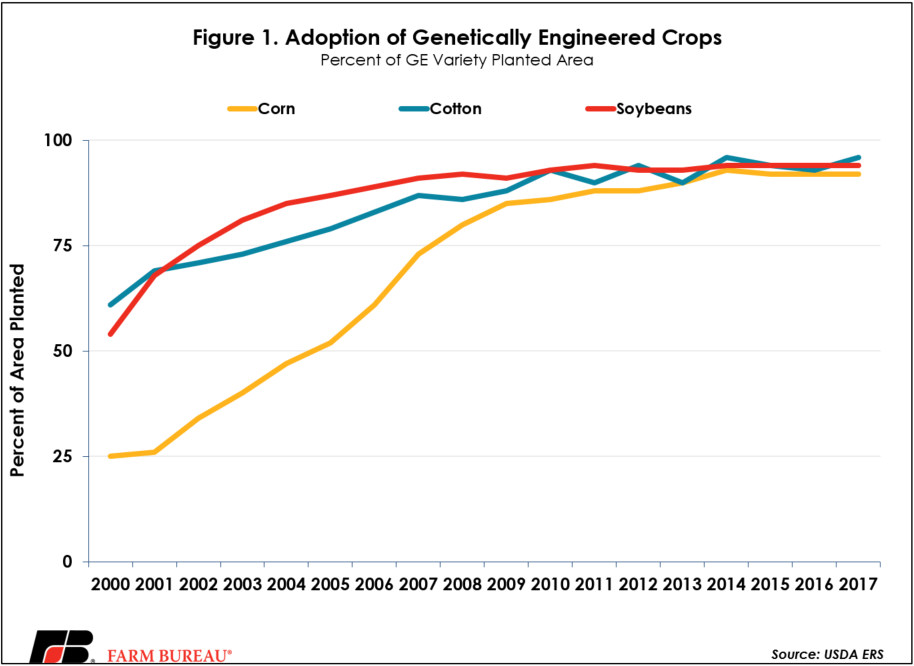Biotechnology Roads Left Untraveled
TOPICS
Trade
photo credit: AFBF Photo, Philip Gerlach
Veronica Nigh
Former AFBF Economist
In discussions about potential restrictions on advances in seed technology, a primary concern has been that impeding technological development would limit the ability of farmers to maximize their productivity. Farmers well know that increases in production will not come from more acres, but rather from the more efficient use of the land and inputs they already have. That reality underpins, why biotechnology is so important to farmers. They are vocal advocates for genetically modified crops, which require less water and fewer chemical applications than conventional crops. In addition, GM crops are better able to survive drought, weeds and insects. Farmers have fought hard to protect their ability to utilize this technology both in the U.S. and around the world. The approval of new traits, however, has slowed in certain key markets, like China. These trade barriers clearly have an impact on agricultural operations, but the ability to quantify that impact has been limited. Yesterday, CropLife International released the results of a study they commission that estimates the impact delayed import approvals in China have had on farm income, job creation, wage growth, economic output and potential business sales. We dive in here.
Two elements drive the fact that what China does on the biotechnology approval front can have a big impact on U.S. farmers. First, China buys a lot of U.S. commodities, and the U.S has widely adopted the use of biotechnology in many of the commodities China is buying. More specifically, by value, in 2017, China was the largest export destination for U.S. soybeans, the second-largest market for U.S. cotton exports and the ninth-largest market for U.S. corn exports. Additionally, by 2017 roughly 90 percent of soybeans, cotton and corn grown in the U.S. had been improved through biotechnology, as highlighted in Figure 1. This makes China’s actions (or rather inactions) on biotech import approvals incredibly important.

In recent years, China has begun taking a considerably longer period to approve new biotech traits, as compared to other major importing countries, such as Mexico, Japan and South Korea. The lack of approval has caused the developers of these new technologies to withhold release of the improved seeds to farmers. Meanwhile, while approval is pending, farmers are unable to take advantage of new technology that could help them increase yields and reduce costs - ultimately costing farmers potential income.
According to CropLife International’s study, that lost income is no small amount. It is estimated that China’s delayed import approvals between 2011 and 2016 cost U.S. farmers nearly $5 billion in farm income. Beyond the farm gate, the study estimates that nearly 34,000 potential jobs were prevented, as well as $4.6 billion in wage growth. These findings confirm the fears farmers have carried for years: restrictions in technology have a direct, negative and significant impact on their bottom line. For more information on The Impact of Delays in Chinese Approvals of Biotech Crops, click here.
As the trade discussions with China unfold over the next several days, tariffs will undoubtedly be discussed. The removal of tariffs - those that existed prior to 2018, those that have been added in response to U.S. tariffs on aluminum and steel, and the tariffs that China has proposed in response to the recent U.S. announcement of proposed U.S. tariffs on Chinese imports as a result of the U.S. 301 Investigation into the forced transfer of U.S. technology and intellectual property, will all be discussed in length. Certainly, the removal of these tariff barriers could help U.S. agricultural products be more competitive in the Chinese market and move us closer to achieving the $25 billion increase in U.S. agricultural exports to China that the president has envisioned. However, to achieve long-term growth in the Chinese market, systemic changes to China’s regulatory system will be necessary. Only then, will the list of foreign trade barriers outlined in USTR’s annual National Trade Estimate Report decline and trade permanently expand.
Trending Topics
VIEW ALL